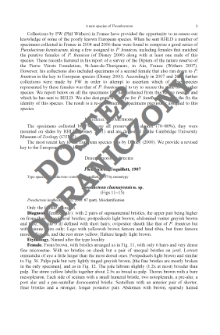
Obiekt
Tytuł: Morphometric plasticity in Prionchulus punctatus (Cobb, 1917) Andrássy, 1958 and Clarkus papillatus (Bastian, 1865) Jairajpuri, 1970 (Nematoda: Mononchida): adaptation to different humus forms?
Inny tytuł:
Annales Zoologici, vol. 50, no 2 ; Morphometric plasticity in Mononchida
Współtwórca:
Polska Akademia Nauk. Muzeum i Instytut Zoologii
Wydawca:
Muzeum i Instytut Zoologii PAN
Miejsce wydania:
Opis:
Incorrect ISSN 0001-6454 ; Bibliogr. p. 169-170 ; P. 165-175 : ill. ; 24 cm
Typ obiektu:
Abstrakt:
Morphometric variability was studied in Prionchulus punctatusand Clarkus papillatus from closely related forest sites: Site 1 (eutrophic to calcic mull humus), site 2 (contiguous tosite 1, eutrophic mull humus with amore or less leached soil), site 3 (acid mull humus), site 4 (located in site 3 but just under the crown of an old oak, moder humus), site 7 (moder humus, developedin a wide area). Results from correspondence analysis for both nematode species from site 2 suggested two distinct population types (a) with small individuals (Pp: 1.85 ± 0.05 mm and 87.2±5.7 μm for body length and tail length respectively; Cp: 1.11±0.02 mm and 78.5±1.9 μm)with typical characteristics of populations collected from acalcic mull and (b) larger individuals (Pp: 2.14 ± 0.04 mm and 100.2 ± 1.8 μm for body length and tail length respectively; Cp:1.21±0.01 mm and 83.3±2.2μm) similar to populations collected from an eutrophic mull. Results from correspondence analysis from site 4 showed that the populations of the two species had intermediate characteristics between populations collected from a mull humus and from a moder humus. Moreover, a laboratory culturing experiment with adult Clarkus papillatus collected from site 3 and cultured on three humus forms (calcic mull, site 1; acid mull, site 3; moder, site 7) showed that this species reproduced successfully on mull acid only. The conjunctural or the structural influence on morphometric plasticity of these species is discussed from a functional ecology aspect.
Czasopismo/Seria/cykl:
Tom:
Zeszyt:
Strona pocz.:
Strona końc.:
Szczegółowy typ zasobu:
Format:
Identyfikator zasobu:
Źródło:
MiIZ PAN, call no. patrz sygn. czas. P.255, vol 50, no 2 ; MiIZ PAN, call no. patrz sygn. czas. P.4314, vol 50, no 2 ; kliknij tutaj, żeby przejść
Język:
Język streszczenia:
Prawa:
Rights Reserved - Restricted Access
Zasady wykorzystania:
Digitalizacja:
Museum and Institute of Zoology of the Polish Academy of Sciences
Lokalizacja oryginału:
Library of the Museum and Institute of Zoology of the Polish Academy of Sciences
Dofinansowane ze środków:
Programme Innovative Economy, 2010-2014, Priority Axis 2. R&D infrastructure ; European Union. European Regional Development Fund
Dostęp:
Kolekcje, do których przypisany jest obiekt:
- Repozytorium Cyfrowe Instytutów Naukowych > Kolekcje Partnerów > Muzeum i Instytut Zoologii PAN > Czasopisma
- Repozytorium Cyfrowe Instytutów Naukowych > Kolekcje Partnerów > Muzeum i Instytut Zoologii PAN > Wydawnictwa MiIZ PAN > Annales Zoologici
- Repozytorium Cyfrowe Instytutów Naukowych > Piśmiennictwo > Czasopisma/Artykuły
Data ostatniej modyfikacji:
2 paź 2020
Data dodania obiektu:
24 wrz 2015
Liczba pobrań / odtworzeń:
52
Wszystkie dostępne wersje tego obiektu:
https://www.rcin.org.pl/publication/73791
Wyświetl opis w formacie RDF:
Wyświetl opis w formacie RDFa:
Wyświetl opis w formacie OAI-PMH:
Obiekty Podobne
Winiszewska-Ślipińska, Grażyna Skwiercz, Andrzej T. Państwowe Wydawnictwo Naukowe (1951–1992) Polska Akademia Nauk. Instytut Zoologii
Winiszewska-Ślipińska, Grażyna
Ahmad, Wasim
Winiszewska-Ślipińska, Grażyna Państwowe Wydawnictwo Naukowe (1951–1992) Polska Akademia Nauk. Instytut Zoologii
Brzeski, Michał W.
Brzeski, Michał Wacław
Wasilewska, Lucyna
Pieczyńska, Ewa

 INSTYTUT ARCHEOLOGII I ETNOLOGII POLSKIEJ AKADEMII NAUK
INSTYTUT ARCHEOLOGII I ETNOLOGII POLSKIEJ AKADEMII NAUK
 INSTYTUT BADAŃ LITERACKICH POLSKIEJ AKADEMII NAUK
INSTYTUT BADAŃ LITERACKICH POLSKIEJ AKADEMII NAUK
 INSTYTUT BADAWCZY LEŚNICTWA
INSTYTUT BADAWCZY LEŚNICTWA
 INSTYTUT BIOLOGII DOŚWIADCZALNEJ IM. MARCELEGO NENCKIEGO POLSKIEJ AKADEMII NAUK
INSTYTUT BIOLOGII DOŚWIADCZALNEJ IM. MARCELEGO NENCKIEGO POLSKIEJ AKADEMII NAUK
 INSTYTUT BIOLOGII SSAKÓW POLSKIEJ AKADEMII NAUK
INSTYTUT BIOLOGII SSAKÓW POLSKIEJ AKADEMII NAUK
 INSTYTUT CHEMII FIZYCZNEJ PAN
INSTYTUT CHEMII FIZYCZNEJ PAN
 INSTYTUT CHEMII ORGANICZNEJ PAN
INSTYTUT CHEMII ORGANICZNEJ PAN
 INSTYTUT FILOZOFII I SOCJOLOGII PAN
INSTYTUT FILOZOFII I SOCJOLOGII PAN
 INSTYTUT GEOGRAFII I PRZESTRZENNEGO ZAGOSPODAROWANIA PAN
INSTYTUT GEOGRAFII I PRZESTRZENNEGO ZAGOSPODAROWANIA PAN
 INSTYTUT HISTORII im. TADEUSZA MANTEUFFLA POLSKIEJ AKADEMII NAUK
INSTYTUT HISTORII im. TADEUSZA MANTEUFFLA POLSKIEJ AKADEMII NAUK
 INSTYTUT JĘZYKA POLSKIEGO POLSKIEJ AKADEMII NAUK
INSTYTUT JĘZYKA POLSKIEGO POLSKIEJ AKADEMII NAUK
 INSTYTUT MATEMATYCZNY PAN
INSTYTUT MATEMATYCZNY PAN
 INSTYTUT MEDYCYNY DOŚWIADCZALNEJ I KLINICZNEJ IM.MIROSŁAWA MOSSAKOWSKIEGO POLSKIEJ AKADEMII NAUK
INSTYTUT MEDYCYNY DOŚWIADCZALNEJ I KLINICZNEJ IM.MIROSŁAWA MOSSAKOWSKIEGO POLSKIEJ AKADEMII NAUK
 INSTYTUT PODSTAWOWYCH PROBLEMÓW TECHNIKI PAN
INSTYTUT PODSTAWOWYCH PROBLEMÓW TECHNIKI PAN
 INSTYTUT SLAWISTYKI PAN
INSTYTUT SLAWISTYKI PAN
 SIEĆ BADAWCZA ŁUKASIEWICZ - INSTYTUT TECHNOLOGII MATERIAŁÓW ELEKTRONICZNYCH
SIEĆ BADAWCZA ŁUKASIEWICZ - INSTYTUT TECHNOLOGII MATERIAŁÓW ELEKTRONICZNYCH
 MUZEUM I INSTYTUT ZOOLOGII POLSKIEJ AKADEMII NAUK
MUZEUM I INSTYTUT ZOOLOGII POLSKIEJ AKADEMII NAUK
 INSTYTUT BADAŃ SYSTEMOWYCH PAN
INSTYTUT BADAŃ SYSTEMOWYCH PAN
 INSTYTUT BOTANIKI IM. WŁADYSŁAWA SZAFERA POLSKIEJ AKADEMII NAUK
INSTYTUT BOTANIKI IM. WŁADYSŁAWA SZAFERA POLSKIEJ AKADEMII NAUK


































